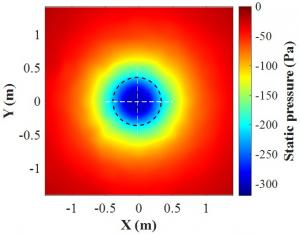
Vortex characteristics of a large-scale Ward-type tornado simulator at Central South University
GA, UNITED STATES, May 13, 2025 /EINPresswire.com/ -- A new large-scale Ward-type tornado simulator has been built at Central South University in 2023. Stationary tornado-like vortices are generated and tested to explore the characteristics of the velocity field and surface pressure field. The results show the significant influence of swirl ratios and little influence of fan speeds on vortex structures. The simulator has the good capability of generating tornado-like vortices.
Tornadoes have caused severe disasters around the world, and have been one of the most violent and damaging natural hazards to human life and property. Experimental simulation of tornado-like vortices is an important method to investigate the effects of tornadoes. In a recent study published in the KeAi journal Advances in Wind Engineering, a group of researchers from China reported a new large-scale Ward-type tornado simulator at Central South University.
In this study, stationary tornado-like vortices were generated and tested in the simulator to explore the characteristics of the three-dimensional velocity field and surface pressure field under different fan speeds and swirl ratios.
“The measured vortices were compared with those of real tornados and numerical models proposed by previous researchers to validate the performance of the simulator,” explains lead author Haiquan Jing. “Our results showed that the simulator successfully reproduced the main characteristics of tornado-like vortices as other simulators, such as WindEEE, VorTECH, and ISU simulator.”
Notably, the fan speed only affected the magnitude of wind speed and had little effect on the vortex structures. The swirl ratio had a significant influence on the vortex structures.
“The simulated results of velocity and surface pressure are close to those of real tornadoes. Moreover, the simulated vortex apparently transformed from a narrow one-celled vortex to a two-celled vortex when the swirl ratio raised from 0.18 to 0.87,” adds Jing.
A downdraft appears at the upper vortex core when the swirl ratio is 0.42 and moves downward when the swirl ratio increases. It reaches the location near the ground as the swirl ratio increases to 0.87.
“Our findings can help deepen our understanding the format and structural development of tornado-like vortices, encouraging further study the effects of tornadoes on different types of structures,” says Jing.
References
DOI
10.1016/j.awe.2025.100038
Original Source URL
https://doi.org/10.1016/j.awe.2025.100038
Funding information
This research was financially supported by the National Natural Science Foundation of China (Nos. 52422811, 51925808 and 52327810) and Tencent Foundation (Xplorer Prize 2021).
Lucy Wang
BioDesign Research
email us here
Distribution channels: Science, Technology
Legal Disclaimer:
EIN Presswire provides this news content "as is" without warranty of any kind. We do not accept any responsibility or liability for the accuracy, content, images, videos, licenses, completeness, legality, or reliability of the information contained in this article. If you have any complaints or copyright issues related to this article, kindly contact the author above.
Submit your press release


